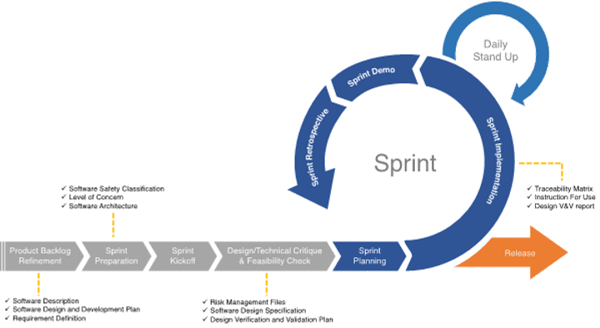By Allen Chen, Senior Quality Engineer at Rook Quality Systems Taiwan Branch
Agile is a practical framework and an iterative approach for product development and project management. With the rise of the internet of things (IoT), cloud computing, artificial intelligence (AI), and machine learning technologies, more and more software as a medical device (SaMD) manufacturers are beginning to leverage these techniques to develop software to better assist health care providers and improve patients’ well-being. Agile practice is becoming an eagerly adopted tool for all software development teams to de-risk their projects and further prepare themselves to embrace software change requests in a complaint manner.
Aside from effectively achieving excellent patient outcomes, the safety of the medical device is definitely the top priority during total product lifecycle of any SaMD. Medical device regulatory compliance as US FDA and EU MDR require SaMD manufacturers to comply with quality system and recognize the relevant international standards as follow:
-
ISO 13485 for quality management system;
-
ISO 14971 for risk management;
-
IEC 62304 for software lifecycle management; and
-
IEC 62366 for usability
Underneath these standards, the developer of SaMD should align the Agile practice with the Quality Management System (QMS) requirements such as design control, risk management, and document control. The customer requirements might be subjected to changes frequently during the active development of the product. Although Agile practice can handle this situation ingeniously and has a deliverable increment in each development interval (usually two weeks), implementing a quality system may become burdensome to demonstrate the documentation compliance from the Product and DevOps team’s perspective.
The dedicated software quality team from Rook Quality Systems intends to help medical device companies develop and maintain an effective and efficient quality system, concurrently with active sprint cadence. We participate in the development process along side with client’s scrum team. Based on the client’s development practices, we divided deliverables required by quality management into ‘digestible’ increments and blended these tasks within Scrum, which is the framework with an Agile mindset for developing, delivering, and sustaining complex systems. Our team have the capability of translating sprint artifacts to technical documentations for the regulatory submission or quality system requirements. Our team can also provide training and help with streamlining this process within your organization for future projects.
Here are the activities we typically involved for better exposure to the project-specific discussions and/or organizational practices:
-
Product Backlog Refinement: Help accumulate user requirements to be done in the project.
-
Sprint Kickoff: Walkthrough of objectives for the following sprint for both design, engineering, and QA/RA.
-
Design/Technical Critique and Feasibility Check: Identify any risks associated with preliminary design, technical implementation, or user-centric hazardous situations. Participate in early design pivots discussions and incorporate mid-sprint feedback.
-
Sprint Planning: Estimate the development team’s capacity and each task in hours.
-
Daily Standup: Each development team member briefly describes any complete items and any impediments that stand in their way.
-
Sprint Demo/Retro: The core working team looks back on the last sprint to identify what went well and what could be improved as well as showcase work.
-
Backlog Grooming: Reprioritization of tickets to accommodate for pivots and unknowns.

Although there is no concrete risk management process in Agile, risk management is arguably the highest priority during medical devices software development. Therefore, it can be said that risk management is implicit in an Agile process, and the only thing the team needs to having a quality assurance personnel leading 14971 practices and instruct how the scrum team would help with risk documentations. Some Scrum artifacts in each event match the documentation requirements of regulation and can be part of the design history file (DHF). Here is a simplified traceability of scrum deliverables to DHF deliverables:
-
Product Backlog Refinement: software description, software design and development plan, user requirement specification, and software requirement specification (design input).
-
Sprint Preparation: software safety classification, level of concern, and software architecture.
-
Design/Technical Critique and Feasibility Check: risk management files, software design specification, and design verification and validation plan.
-
Sprint Implementation:
-
Development: traceability matrix, instruction for use (user manual), updated design verification plan, and design verification report.
-
System test: updated design validation plan and design validation report
-
Sprint Demo/Retro: updated risk management file
-
Release: device master record, software deployment plan, software maintenance plan, and release record
Whether you are a medical device developer who wants to adopt the Agile process or a software development team who wants to step into the medical device field, the RookQS team can provide practical support in both Agile and quality system perspective. Please contact us at allen.chen@rookqs.com if you have any questions.